Todirostrum
Todirostrum is a bird genus in the New World flycatcher family Tyrannidae. Established by René Primevère Lesson in 1831, it contains the following seven species:[1]
| Image | Name | Common name | Distribution |
|---|---|---|---|
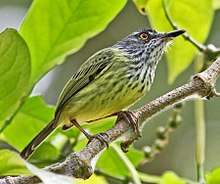 | Todirostrum maculatum | Spotted tody-flycatcher | Bolivia, Brazil, Colombia, Ecuador, French Guiana, Guyana, Peru, Suriname, Trinidad and Tobago, and Venezuela |
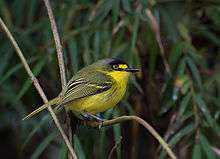 | Todirostrum poliocephalum | Yellow-lored tody-flycatcher or grey-headed tody-flycatcher, | Brazil, occurring from Southern Bahia southwards to Santa Catarina |
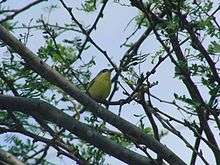 | Todirostrum viridanum | Maracaibo tody-flycatcher, | Venezuela |
 | Todirostrum nigriceps | Black-headed tody-flycatcher, | Colombia, Costa Rica, Ecuador, Panama, and Venezuela |
| Todirostrum pictum | Painted tody-flycatcher, | eastern-southeastern Venezuela and the northeastern states of Brazil of the Amazon Basin | |
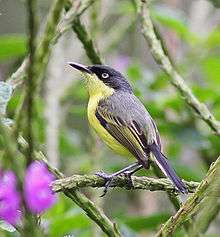 | Todirostrum cinereum | Common tody-flycatcher or black-fronted tody-flycatcher, | southern Mexico to northwestern Peru, eastern Bolivia and southern Brazil. |
| Todirostrum chrysocrotaphum | Yellow-browed tody-flycatcher, | southern Amazon Basin of Brazil, also Amazonian Colombia, Ecuador, Peru, and Bolivia | |
| Todirostrum | |
|---|---|
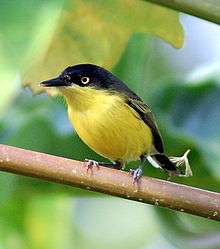 | |
| Common tody-flycatcher (Todirostrum cinereum) | |
| Scientific classification | |
| Kingdom: | Animalia |
| Phylum: | Chordata |
| Class: | Aves |
| Order: | Passeriformes |
| Family: | Tyrannidae |
| Genus: | Todirostrum Lesson, 1831 |
| Species | |
|
see text | |
The name Todirostrum is a combination of the genus name Todus (for the todies) and the Latin word rostrum, meaning "beak".[2]
References
- Gill, Frank; Donsker, David, eds. (2019). "Tyrant flycatchers". World Bird List Version 9.2. International Ornithologists' Union. Retrieved 29 June 2019.
- Jobling, James A. (2010). The Helm Dictionary of Scientific Names. London, UK: Christopher Helm. p. 387. ISBN 978-1-4081-2501-4.
This article is issued from Wikipedia. The text is licensed under Creative Commons - Attribution - Sharealike. Additional terms may apply for the media files.